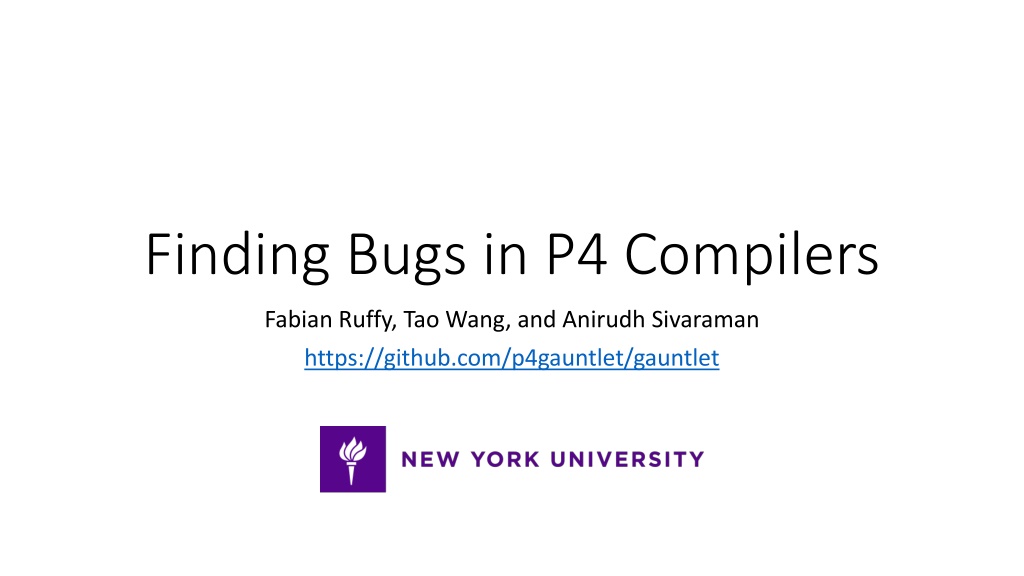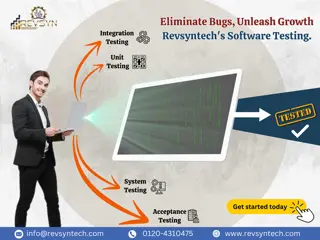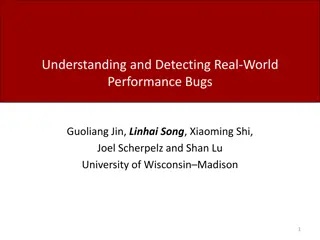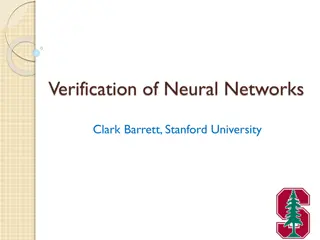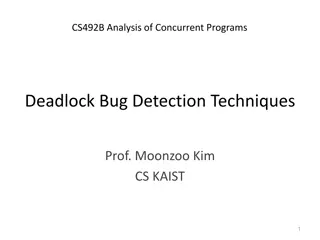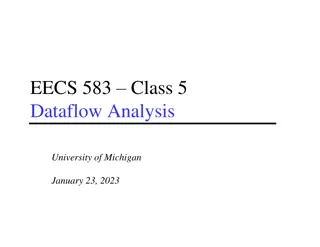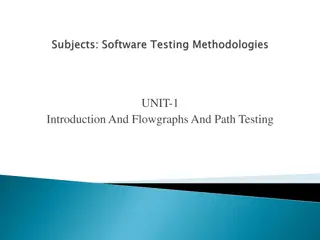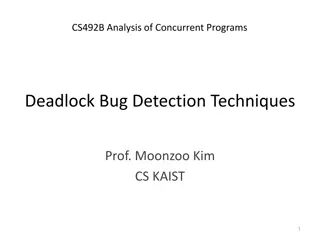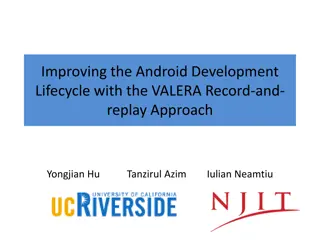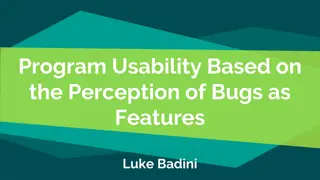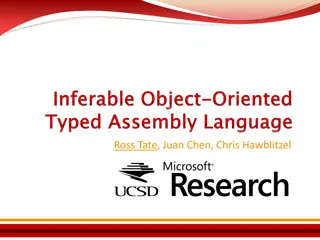Finding Bugs in P4 Compilers
This presentation discusses the identification of bugs in P4 compilers through a combination of fuzzing and formal methods. It introduces Gauntlet, a tool suite developed for analyzing P4 compilers, and highlights the importance of ensuring the reliability of compilers for the P4 language due to the critical role they play in data plane equipment and network infrastructure. The talk emphasizes the significance of detecting and rectifying errors in packet processing to maintain operational integrity and explores the current landscape of P4 and its adoption by various commercial enterprises.
Download Presentation

Please find below an Image/Link to download the presentation.
The content on the website is provided AS IS for your information and personal use only. It may not be sold, licensed, or shared on other websites without obtaining consent from the author.If you encounter any issues during the download, it is possible that the publisher has removed the file from their server.
You are allowed to download the files provided on this website for personal or commercial use, subject to the condition that they are used lawfully. All files are the property of their respective owners.
The content on the website is provided AS IS for your information and personal use only. It may not be sold, licensed, or shared on other websites without obtaining consent from the author.
E N D
Presentation Transcript
Finding Bugs in P4 Compilers Fabian Ruffy, Tao Wang, and Anirudh Sivaraman https://github.com/p4gauntlet/gauntlet
What this talk is about How to find bugs in compilers for the P4 language How to combine fuzzing and formal methods to find bugs Gauntlet, our tool suite that finds bugs in P4 compilers Results and Future Work 2
What is P4? High-level programming language for network data planes Allows for protocol flexibility Specifies a packet processing pipeline Compiled and loaded into target platform Open and standardized P4: Programming Protocol-Independent Packet Processors Pat Bosshart, Dan Daly, Glen Gibb, Martin Izzard, Nick McKeown, Jennifer Rexford, Cole Schlesinger, Dan Talayco, Amin Vahdat, George Varghese, David Walker ACM SIGCOMM Computer Communications Review (CCR). Volume 44, Issue #3 (July 2014) 3
P4: Current Landscape Language has reached a stable state with P416 Increasingly adopted by commercial enterprises Back ends: Barefoot Tofino, Cisco Silicone One, Xilinx Netcope P4, Users: Google, Broadcom, Nokia, Orange, Princeton P416 has a reference compiler: P4C Has status similar to LLVM/GCC; represents the language specification Users convert the generated IR to their target instruction set P4C transforms input streamlines code and includes code quality passes
Compiler Context: P4C IR with target-specific extensions Same IR Mid End Back End Front End P416 Parser P4 Program IR IR IR Target-independent nanopasses (25+ distinct transformations) Target-specific nanopasses IR: Intermediate Representation Nanopass: Small program transformation using IR
Do We Know if P4C Compiles Correctly? Data plane equipment is part of core infrastructure High impact of erroneous compilation Faulty packet processing hard to detect Prior research shows that GCC/LLVM had hundreds of subtle bugs P4C certainly no exception How can we ensure that P4 compilers are reliable?
Stages of Testing a Compiler Adversarial Test Example Available P4 Tools Level Input Class Sequence of ASCII characters Random bit stream 1 American Fuzzy Lop (AFL) P4Fuzzer Sequence of words, etc. Non-alphanumeric names 2 Increased Precision Syntactically correct program Missing brackets 3 Type-correct program Adding int to a header 4 Statically conforming program Exit within a function 5 Random program generation combined with semantics (our work) Dynamically conforming program Header Initialization 6 Model-conforming program Input that leads to wrong output 7 Differential testing for software. , McKeeman, William M., Digital Technical Journal 10.1 (1998): 100-107.
Sequence of ASCII characters Sequence of words, white space Two Types of Bugs Syntactically correct program Type-correct program Statically conforming program Crash Bug Obvious bug Program input causes the compiler to terminate abnormally All bugs up to level 5 Dynamically conforming program Model-conforming program Miscompilation or Semantic Bug No error raised, but behavior of program is altered Typically caused by misbehaving compiler passes Level 6 and above
Sequence of ASCII characters Sequence of words, white space How to Find Crash Bugs in P4? Syntactically correct program Type-correct program Statically conforming program We target level 5 P4 compilers mature enough to handle 1-3 Generate random programs that are valid Identify programs that cause a non-zero exit code May be a crash, out-of-memory error, or timeout Could also be a program that is incorrectly rejected We can also use the random programs for finding semantic bugs Dynamically conforming program Model-conforming program
Sequence of ASCII characters Sequence of words, white space How to Find Semantic Bugs in P4? Syntactically correct program Type-correct program Statically conforming program Compiler Verification? Complete but costly and inflexible Need to write proofs for every new target architecture Differential testing? Cannot compare outputs across different target backends P4 too young to have multiple compilers for a single target Translation validation? Only requires semantics, no manual proofs or multiple compilers Difficult to fully implement, butP4 s restrictions make it a good fit Dynamically conforming program Model-conforming program
Why Translation Validation for P4? Traditionally limited because of undecidability However, P4 s language properties are a great fit for formal methods Language core not Turing-complete Bounded loops, static allocation, no arbitrary code execution Pipeline-structure provides well-defined state All output variables known at the beginning of the function Possible to track and return fixed program state We can compare entire programs!
The Gauntlet Framework Toolbox of testing software Random code generator P416 semantic interpreter Translation validation and testing pipeline Three concrete techniques to find bugs 1. Random code generation to find crash bugs 2. Translation validation to identify miscompilations 3. Model-based testing for closed-source compilers Use semantics to infer packet input and expected output Generate packets that trigger different program paths
P4: Semantic Representation Use the Z3 SMT solver for formal methods P4 programs are represented as Z3 SMT-LIB2 formulas Input/output of the program is modelled as Z3py bit vector datatype Final expression: datatype of if-then-else expressions Add branches per table or conditional in the program Large portions of the language implemented and tested
Normalized Z3 Semantics: Example P4 Program Semantic Representation struct Hdr {bit<8> a; bit<8> b;} Symbolic input: t_key, t_action, hdr Symbolic output: hdr_out control ingress(inout Hdr hdr) { action assign() { hdr.a = 1; } table t { key = hdr.a : exact; actions = { assign(); NoAction(); } default_action = NoAction(); } main { t.apply(); } } hdr_out = if (hdr.a == t_key): if (1 = t_action): Hdr(1, hdr.b) otherwise: Hdr(hdr.a, hdr.b) otherwise: Hdr(hdr.a, hdr.b)
The P4-to-Z3 Interpreter Extension to the P4 compiler Uses IR generated by P4Parser to generate Z3 expressions Target-independent Only needs P4 model to produce semantics for a P4 program Designed to handle all forms of the P4 language Whatever the parser accepts is transformed to Z3 P4 program is converted into a normalized form Extensively tested 650 P4-16 tests + ~100 custom tests
Technique 1: Bludgeon Program generator modelled after Csmith But does not avoid undefined behavior Simpler P4C extension that uses P4C IR to generate expressions Grows the AST by randomly picking from available IR expressions Code generation is guided according to P416 specification A correctly rejected, generated program is a bug in Bludgeon Small fragments of the language sufficient to detect bugs Branching is limited State-space explosion not a concern
Bludgeon Design Details Each back end is a template that defines what declarations to produce which program pipe (ingress, parser ) to fill with random code Configuration based on global probabilities Back ends set probabilities of unsupported constructs to zero Back ends: v1model (simple switch), tna (tofino 1), psa Usage: p4c/build/p4bludgeon --output out.p4 --arch tna
Technique 2: Gauntlet Validation P4C Non-zero exit code Compile Generate P4 program Crash bug Bludgeon Emit IR pass1.p4 Gauntlet interpreter Pass_1.p4 IR passes Pass_1.p4 Pass_1.p4 Yes Unstable code OK Equivalent? Equivalent? Equivalent? No No Caused by undefined behavior? Validation bug
Gauntlet Validation - Details Requires full access to the IR of the compiler Parses P4 files emitted by ToP4 visitor Semantics are a normalized representation of the P4 program Undefined behavior taints this representation Usage python3 validate_p4_translation.py -input out.p4
Technique 3: Model-based Testing P4C Generate Non-zero exit code Compile Crash bug P4 program Bludgeon Load target Recorded output Gauntlet interpreter Feed packets OK Generate test files test1.stf Pass_1.p4 Pass_1.p4 Pass_1.p4 Target device Expected output Validation bug
Model-based Testing: Details Requires test framework Input/output pairs are computed based on branch conditions Produces STF files for testing Converts STF to PTF tests for Tofino Not yet supported: Insertion of control plane entries Usage python3 generate_p4_test.py -input out.p4
Example of a Real Bug void assign_eth(inout bit<16> type) { if (type == 0) { type = IP6_TYPE; return; } type = IP4_TYPE; return; } void assign_eth(inout bit<16> type) { if (type == 0) { ; return; } type = IP4_TYPE; return; } Assignment removed! DefUse Analysis control ingress(Header h) { assign_eth(h.eth.eth_type); } control ingress(Header h) { assign_eth(h.eth.eth_type); }
Tracked Results Found 96 compiler bugs in 8 months 62 compiler crashes, 25/62 in the Tofino compiler back end 34 semantic bugs, 7/34 in in the Tofino compiler back end Resulted in 6 specification changes Gauntlet is now a part of the continuous integration pipeline of P4C!
Details: Bug Locations Front End: 38/96 bugs, exclusively detected in P4C A lot of type-checking issues Mid End: 21/96, bugs were largely semantic More advanced transformations? Back End: 37/96, primarily in the Tofino compiler Front- and mid-end bugs also apply to the Tofino compiler
Limitations The bug-finding techniques require semantics Bugs in the semantics lead to false positives Non-programmable blocks not specified Model-based testing fundamentally limited Parser semantics not efficient and well tested Full (single-thread) validation of switch.p4 takes ~5 hours Semantics are specifically tailored for specification equality checks Not general, may not capture all safety or functional properties Cannot identify more than correctness bugs
Future Work and Ideas Extend translation validation to back ends Guarantees correctness during the entire compilation process Requires access to the back end and its IR Facilitate more aggressive optimizations Skip compiler optimizations that produce incorrect code Allows fail-safe experimentation Find missed optimizations and performance bugs Identify when an optimization should have been applied Identify compiler passes negatively affecting performance
Summary on Contributions P4 random program generator that embraces undefined behavior Target-independent, symbolic P4 interpreter Framework that finds miscompilations in P4 programs for every compilation step in the reference compiler end-to-end on closed-source P4 compilers Identified more than 90 bugs within four months of testing Reported to open-source community and fixed Also found many bugs in the Tofino compiler https://github.com/p4gauntlet/gauntlet
Performance Numbers Program Architecture Lines of Code Time (mm:ss) tna_simple_switch.p4 TNA 1940 00:05 switch_tofino_x0.p4 TNA 5751 00:51 switch_tofino2_y0.p4 TNA 6024 00:53 fabric.p4 V1Model 958 00:02 switch.p4 (from P4-14) V1Model 5894 10:20
